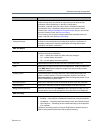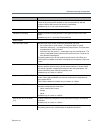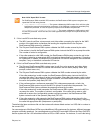
Conference Manager Configuration
Polycom, Inc. 219
3 If this is an MCU-controlled entry queue:
a The MCU uses its call flow, voice prompts, and video slides, prompting the caller for the VMR
number of the destination conference and sending the response back to the Polycom
RealPresence DMA system for validation.
b The Polycom RealPresence DMA system validates the VMR number entered by the caller.
If the number is invalid, the RealPresence DMA system instructs the MCU to re-prompt the caller.
The number of retries is configurable.
c If the caller entered a valid VMR number, the RealPresence DMA system routes the call to the
conference (selecting an appropriate MCU and starting the conference if necessary). Prompting
for a passcode, if needed, is handled by the conference IVR service assigned to the conference
template, if any, or the default conference IVR service.
4 If this is a RealPresence DMA-controlled entry queue:
a The Polycom RealPresence DMA system uses its call flow, voice prompts, and video slides,
sending commands to the MCU to control the interaction with the caller (display slides, play
prompts, collect tones, etc.).
b The Polycom RealPresence DMA system validates the VMR number entered by the caller.
If the caller entered an invalid number, the RealPresence DMA system instructs the MCU to
re-prompt the caller. The number of retries is configurable. If the caller fails to enter a valid number
or enters the (configurable) operator request command, the RealPresence DMA system routes
the call to the operator (help desk) SIP URI.
c If the conference has a conference passcode (PIN), chairperson passcode, or both, the
RealPresence DMA system instructs the MCU to prompt for and collect the passcode. The
RealPresence DMA system validates the passcode entered by the caller.
If the caller entered an invalid passcode, the RealPresence DMA system instructs the MCU to
re-prompt the caller. The number of retries is configurable. If the caller fails to enter a valid
passcode or enters the (configurable) operator request command, the RealPresence DMA
system routes the call to the operator (help desk) SIP URI.
d If the caller entered a valid passcode, the RealPresence DMA system routes the call to the
conference (selecting an appropriate MCU and starting the conference if necessary), assigning
the caller the appropriate role (chairperson or participant).
The default dial plan contains a dial rule that routes calls whose dialed number is a VEQ dial-in number to
the correct VEQ.
You can create up to 60 different VEQs to provide different IVR experiences (for instance, different language
prompts or different greetings). You can designate one of the MCU-controlled VEQs as the Direct Dial VEQ,
and the system will use it for calls dialed without a VEQ or VMR number. For instance, if a call’s dial string
Note: Valid “Speed Dial” formats
For RealPresence DMA-controlled VEQ numbers, the RealPresence DMA system recognizes two
“speed dial” SIP dial string formats:
• <veq number>**<vmr number> — The system validates the VMR number. If it’s valid, the caller
bypasses the prompt for the destination conference. If the VMR has a conference passcode (PIN),
chairperson passcode, or both, the system prompts for and validates the passcode.
<veq number>**<vmr number>**<passcode> — The system validates the VMR number, and if
it’s valid, the passcode. If both are valid, the caller bypasses both prompts and is placed directly into
conference.


















